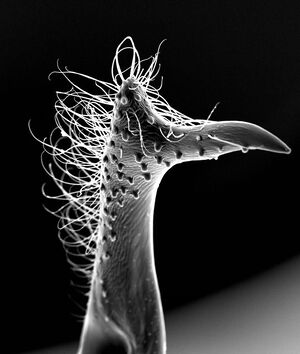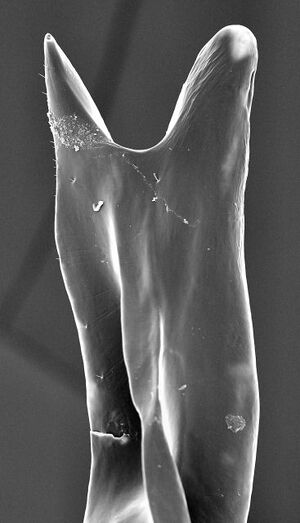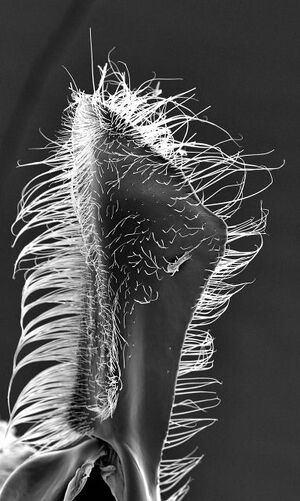Neivamyrmex mojave
| Neivamyrmex mojave | |
|---|---|

| |
| Scientific classification | |
| Kingdom: | Animalia |
| Phylum: | Arthropoda |
| Class: | Insecta |
| Order: | Hymenoptera |
| Family: | Formicidae |
| Subfamily: | Dorylinae |
| Genus: | Neivamyrmex |
| Species: | N. mojave |
| Binomial name | |
| Neivamyrmex mojave (Smith, M.R., 1943) | |
This species has been previously known only from the type specimen, from an unknown locality in the Mojave Desert. A specimen from north of Adelanto was picked up dead on the ground. (Snelling and Snelling 2007)
Identification
Neivamyrmex mojave is evidently nearest to Neivamyrmex microps and superficially looks much like that ant. However it may be distinguished from that species by the non-toothed volsella, and differences in coloration. This species might also be mistaken for Neivamyrmex minor but may be readily distinguished from that species by the small size of the ocelli. (Snelling and Snelling 2007)
Distribution
United States: Southern California; Mexico: Baja California Sur.
Distribution based on Regional Taxon Lists
Nearctic Region: United States (type locality).
Neotropical Region: Mexico.
Distribution based on AntMaps
Distribution based on AntWeb specimens
Check data from AntWeb
Countries Occupied
| Number of countries occupied by this species based on AntWiki Regional Taxon Lists. In general, fewer countries occupied indicates a narrower range, while more countries indicates a more widespread species. |

|
Estimated Abundance
| Relative abundance based on number of AntMaps records per species (this species within the purple bar). Fewer records (to the left) indicates a less abundant/encountered species while more records (to the right) indicates more abundant/encountered species. |

|
Biology
Castes
Only known from the male caste. The recently described Neivamyrmex nyensis may be the worker form of this species.
Male
  
| |
| . | |
Nomenclature
The following information is derived from Barry Bolton's Online Catalogue of the Ants of the World.
- mojave. Eciton (Neivamyrmex) mojave Smith, M.R. 1943e: 196, fig. 1 (m.) U.S.A. (California).
- Type-material: holotype male, 1 paratype male.
- Type-locality: holotype U.S.A.: California, Mojave Desert, 15.x.1925 (J.M. Swaine); paratype with same data.
- Type-depository: USNM.
- Combination in Neivamyrmex: Borgmeier, 1955: 633.
- Status as species: Creighton, 1950a: 73; Smith, M.R. 1951a: 781; Borgmeier, 1955: 633 (redescription); Watkins, 1972: 352 (in key); Watkins, 1976: 25 (in key); Smith, D.R. 1979: 1331; Snelling, R.R. & George, 1979: 31; Watkins, 1985: 485 (in key); Bolton, 1995b: 290; Ward, 2005: 62; Snelling, G.C. & Snelling, 2007: 482.
- Distribution: Mexico, U.S.A.
Unless otherwise noted the text for the remainder of this section is reported from the publication that includes the original description.
Description
Male
Length 8.25 mm.
Head approximately one and one-half times as broad as long. Eye rather small, moderately convex, protuberant. Ocelli small, only slightly extending above the general surface of the head; summit of protuberance concave; lateral ocellus at least twice its greatest diameter from inner margin of eye. Region of head between eye and lateral ocellus appearing round when head is viewed anteriorly. Frontal carinae with a pronounced groove between them extending from posterior border of clypeus to anterior ocellus; each carina not forming a distinct ridge above an antennal socket. Antennal scape robust, approximately as long as combined length of first 3 funicular segments; all funicular segments except the first two distinctly longer than broad. Anterior border of clypeus approximately straight. Mandible moderately long, curved, tapering from base to apex and ending in an in curved point that is neither long nor unusually acute. Eye not occupying all of the side of the head, there being a small area between the border of the eye and the mandible and a much larger area posterodorsad of the eye. Region of head behind ocelli flat or weakly concave. Occipital flange lacking. Head, from above, much more produced behind the eyes than in minus. Thorax approximately one and one-half times as long as high, somewhat projecting above head; mesonotum slender, convex, bearing anteromedian and parapsidal lines. Epinotum, in profile, subtruncate or weakly concave. Legs unusually small. Anterior half of petiole with sharply margined sides; ventral surface with a prominent protuberance. Gaster slender, compressed, with distinct constrictions between segments. Seventh gastric sternum (hypopygium) with 2 acute lateral teeth and a less acute median tooth.
Head shining; thorax and gaster appearing more subopaque because of the dense, short, closely appressed hairs; thorax more sub opaque than gaster. Punctation somewhat concealed by the hairs, most distinct on the thorax, especially the mesonotum and pleura.
Hairs yellowish, short, dense; excluding head, much appressed on all parts of body except venter; on head longer and more erect, especially on clypeus and mandibles.
Head, thorax, and petiole dark brown, almost black; gaster light brown forming a distinct contrast with remainder of body. Wings very pale, with extremely light veins and distinct brown stigma.
Type Material
United States National Museum No. 56598. The holotype and one paratype male were collected at the type locality on October 15, 1925, by J. M. Swaine. The paratype male differs from that of the holotype in its much darker head, thorax, and petiole (approximately black) and the infuscated base of the first gastric segment.
References
- Borgmeier, T. 1955. Die Wanderameisen der neotropischen Region. Stud. Entomol. 3: 1-720 (page 633, Combination in Neivamyrmex)
- Smith, M. R. 1943f. A new male legionary ant from the Mojave Desert, California. Lloydia 6: 196-197. (page 196, fig. 1 male described)
- Snelling, G. C.; Snelling, R. R. 2007. New synonymy, new species, new keys to Neivamyrmex army ants of the United States. In Snelling, R. R., B. L. Fisher, and P. S. Ward (eds). Advances in ant systematics (Hymenoptera: Formicidae): homage to E. O. Wilson - 50 years of contributions. Memoirs of the American Entomological Institute 80:459-550. PDF
References based on Global Ant Biodiversity Informatics
- Johnson, R.A. and P.S. Ward. 2002. Biogeography and endemism of ants (Hymenoptera: Formicidae) in Baja California, Mexico: a first overview. Journal of Biogeography 29:10091026/
- Snelling G. C. and R. R. Snelling. 2007. New synonymy, new species, new keys to Neivamyrmex army ants of the United States. Memoirs of the American Entomological Institute 80: 459-550

